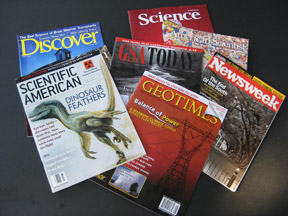I've been cut off. Unfortunately, I'm not talking about a steady stream of allowance from my parents or a trust fund. No, I'm talking about access to scientific journals. Students typically have access to peer-reviewed scientific journals through their universities (and great resources such as the Web of Knowledge and ScienceDirect). These are the basis of our academic lives. It is where we hope that one day our studies and hard work will be published. To show the world what we've been specializing in and also to have a record of our research to share with the global scientific community. Or at least theoretically. But scientific journal access is EXPENSIVE!!
Nature and Science are the two highest rated multidisciplinary scientific journals in the world by impact factor ratings (Thomson Reuters) and SJR ranking (SCImago Journal & Country Rank). If you want to get access to the full articles published in such journals, you need to buy individual articles for about $30 a pop OR be a student with access rights. Students receive access to scholarly journals because part of their tuition fees pay the very very costly price of institutional subscriptions. This article also moans about these high prices which can be over $20,000 per year PER journal. Can you imagine? Now that I have my masters degree, I am no longer paying tuition and I've been given a swift kick in the butt on the way out the door to the real world again. During my quick departure, they ripped off the band-aid of academia and left me without access to my coveted journals. As a certified scientist, I feel naked without my journals. How am I supposed to continue without them? Do they assume that since I am going into industry and not staying in academia that I am no longer an academic? How does scientific knowledge even reach the public if it is locked in the high towers of university access?
Luckily, with the increasing prices to universities and a general outcry to lack of access to knowledge, things are changing (still very slowly, but change is happening!). "Open access" journals are becoming more popular and widely read. Journals such as PLoS One are still peer-reviewed and very well respected, but they are open access and meant as a means to share and exchange knowledge. Some journals have opened access to their archives, allowing free access to their older articles (The Royal Society has done this, so has JSTOR to a limited degree). Access to scientific research is especially challenging for developing nations who do not have the money to subscribe to these journals (which is ironic, because developing nations have the highest loss of biodiversity and lack scientific innovations which can reduce environmental degradation). The United Nationals Environment Programme has recognized this problem and has created OARE, Open Access to Research in the Environment.
 If you would like to read my very first academic article which I co-authored, the full text should be accessible via this link. It is called "The oldest monitoring site of the Alps revisited: accelerated increase in plant species richness on Piz Linard summit since 1835" and was published in the journal called Plant Ecology & Diversity. The citation for it is:
If you would like to read my very first academic article which I co-authored, the full text should be accessible via this link. It is called "The oldest monitoring site of the Alps revisited: accelerated increase in plant species richness on Piz Linard summit since 1835" and was published in the journal called Plant Ecology & Diversity. The citation for it is:Wipf S, Stöckli V, Herz K & Rixen C (2013) The oldest monitoring site of the Alps revisited: accelerated increase in plant species richness on Piz Linard summit since 1835. Plant Ecology & Diversity.Although this is an article you normally have to pay for, it appears to be open access for the moment. If for some reason you cannot access it, please let me know and I will send you a copy! (By the way, my second scientific article, based on my masters thesis, is in progress, and this time I will be the first author! It's a long process, but I will give you updates)
For more information on scientific journals and open access journals, here are a few links.
- This is a list of the highest rated journals in my field, Ecology. Most of these require very costly subscriptions. I miss them!
- Here is an article from the New York Times discussing scholarly journal access issues.
- This blog is dedicated to open access news and updates
- There is a Directory of Open Access Journals (DOAJ)
- A small list of open access journals - Oxford Journals
Bergstrom, C.T., and T.C. Bergstrom. The costs and benefits of library
site licenses to academic journals. Proceedings of the National Academy of
Sciences, 101(3), 897-902. January 20, 2004.
Interestingly, PNAS has added a new option that puts the onus of open access on the authors. They provide an open access option for authors submitting articles to be published in their journal which requires the institute from which the authors originate to hold a full institutional subscription to the PNAS journal (which costs up to $10,010) and then gives the authors a reduced price to submit their article. Interesting. I am curious if this business model works. This way, PNAS still receives funding through the larger institutional subscription but loses a little bit of money on individual submissions and future access to these articles. It's a step toward sharing knowledge but with a high cost still associated with it.Have you been affected by being cut off from access too? How do you feel about this? What would you be interested in researching if you had access to scientific journals?


No comments:
Post a Comment